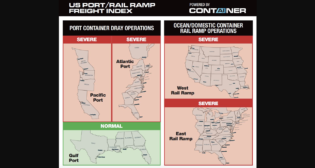
Canada’s Trudeau has final say on CP-NS merger
Written by David Thomas, Canadian Contributing EditorRail industry cogitation focuses so far on Canadian Pacific's (CP) prospects for securing Surface Transportation Board (STB) approval for its—at first friendly and now increasingly hostile—attempt to take over Norfolk Southern (NS). Unremarked has been the even-less predictable, but equally essential, attitude of Canada's transportation and business regulators to a deal that would see one of the country's two Class I’s disappear into the alphabet soup of American megamergers.
Just how would Canada react to the notion of an NSCP reporting mark on the flanks of black and red locomotives running over tracks largely financed by public funds back in the 1800s and still revered as the “National Dream”?
Railway Age asked the office of Canada’s new Minister of Transport, ex-astronaut Marc Garneau, to spell out the regulatory hurdles an NS-CP (or CP-NS) merger proposal would have to clear. CP is, after all, a Canadian company subject to Canadian law governing business combinations generally, and those in the transportation sector particularly. Canadian National, for example, would have to secure an Act of Parliament just to move its head office from Montreal, let alone merge with another carrier.
Transport Canada Media Officer Julie-Anne Codaire, responded Dec. 17, 2015 with the two-stage process a CP-NS merger application would face in Canada:
“Under the Competition Act, mergers of all sizes and in all sectors of the economy are potentially subject to review by the Commissioner of Competition. Before proceeding with a merger, parties are also required to notify the Commissioner of Competition if the target’s assets in Canada or revenues from sales in or from Canada exceed $86 million, and the combined Canadian assets or revenues of the parties, from or into Canada, exceed $400 million.
“If the Competition Act’s thresholds are met, the parties must also notify the Minister of Transport of the proposed transaction under the Canada Transportation Act. In particular, they must provide information regarding the public interest as it relates to national transportation (for example, an assessment of the impacts on communities and users of the transportation system).
“If the Minister of Transport believes that the proposed transaction raises issues with respect to the public interest as it relates to transportation, he may direct the Canadian Transportation Agency or another person to examine those issues, and the transaction cannot proceed without Governor in Council approval.
“Given that the proposal is in its early stages, we are not in a position to comment on whether a review of this merger will take place under the Canada Transportation Act.”
The key phrase is that no transaction could proceed “without Governor in Council approval.” The Governor in Council is Canada’s supreme authority, albeit an entirely fictitious one. The Governor-General is the titular representative of Britain’s Queen Elizabeth in Canada, which, maddeningly to some, is still constitutionally a monarchy under the British Crown. The Governor-General is in truth merely Canada’s ceremonial head of state and never, ever meets with his “council” to decide anything. Governor in Council is a euphemism for the federal cabinet, composed of elected Members of Parliament chosen and tightly managed by the Prime Minister.
 The reality is that a CP-NS merger would need the personal approval of Prime Minister Justin Trudeau (pictured). The essential question, then, is whether Trudeau II (his father preceded him as Prime Minister from 1968 to 1974) would want to be remembered as the betrayer of the greatest accomplishment of the country’s very first Prime Minister, John A. Macdonald. The hard-drinking Macdonald literally bet Canada’s public finances on completion of the Canadian Pacific Railway as a means of blocking “manifest destiny,” the U.S. catch-phrase for takeover of the Canadian West.
The reality is that a CP-NS merger would need the personal approval of Prime Minister Justin Trudeau (pictured). The essential question, then, is whether Trudeau II (his father preceded him as Prime Minister from 1968 to 1974) would want to be remembered as the betrayer of the greatest accomplishment of the country’s very first Prime Minister, John A. Macdonald. The hard-drinking Macdonald literally bet Canada’s public finances on completion of the Canadian Pacific Railway as a means of blocking “manifest destiny,” the U.S. catch-phrase for takeover of the Canadian West.
CP, for its part, reaffirmed its belief that regulatory authorities in both countries would bless the proposed union because of its business sense.
“CP is committed to creating a coast-to-coast railway combination that is pro-competitive, pro-customer and generates significant shareholder value,” CP Assistant Vice President Martin Cej told Railway Age after we provided him with a copy of the Canadian government’s perspective on rail mergers. “We are confident that our proposal would meet regulatory requirements.”



